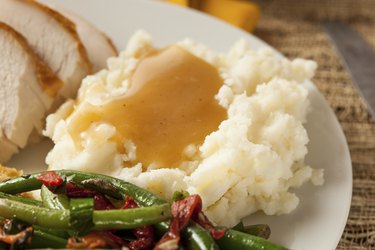
Not to be confused with brown sauce, also called espagnole sauce -- which is reduced, or cooked-down, stock -- brown gravy gets its creamy, thick consistency from a thickener, like flour, blended with liquid. Once you master the techniques for brown gravy, you'll find plenty of uses for the savory mixture, from serving it over biscuits for breakfast; slathered on roast beef sandwiches for lunch; or atop mashed potatoes, baked squash, hamburger steaks or pot roast for dinner.
Make a Roux to Start
Video of the Day
Any thickened gravy begins with a roux, the French term for a cooked mixture of flour and fat. Use about 3 tablespoons each of flour and fat for each 2 cups of liquid. If you have pan drippings and brown bits left from cooking meat or poultry, make your roux in the pan, scraping its bottom to lift up all the cooked-on bits. Add more butter or oil as needed, and cook the mixture for 3 to 4 minutes, stirring frequently.
Video of the Day
Add Liquid to Finish
Get ready to make the gravy by heating whatever liquid you're using until it is very warm. Use beef or chicken stock, water dissolved with a beef or poultry bouillon cube, leftover water from cooking potatoes, red or white wine or a combination of any of these liquids.
Add the liquid, vigorously whisking it into the flour and fat mixture in 1/2 cup intervals. The mixture will thicken quickly between each addition of liquid until it becomes smooth. Finish the gravy by cooking it for about 5 more minutes.
Solve Gravy Problems
Simple fixes exist for common gravy problems:
- For gravy that's too thick, add enough liquid until the gravy reaches the consistency you want.
- To thicken thin gravy, whisk in a paste of about 1 tablespoon of flour you've mixed with about 3 tablespoons of the thin, hot gravy.
- To prevent lumps in your gravy, add each portion of liquid during the cooking process only after the mixture currently in the pan has thickened.
- If the gravy appears lumpy as you are adding liquid, continue cooking the gravy back down to the thick stage, whisking vigorously and constantly until the lumps converge into one, thick mass. Then begin adding hot liquid again, whisking until the mixture is thick and smooth between each addition.
Add More Flavor
Your gravy's flavor increases when you use savory liquid, but you can also increase flavor with salt, pepper, dried herbs or a tablespoon of tomato paste or sherry. Or, add the browned bits from cooking meat or poultry to the gravy after it's done by deglazing the cooking pan; use a small amount of whatever liquid you're using in the gravy and a spatula to scrape up all the pieces of meat stuck to the pan, keeping it on low heat as you deglaze, then pour that liquid into the cooked gravy.
Make Gravy Variations
Classic brown gravy variations include Irish brown onion gravy, thick with caramelized onions and served over sausages or pork pies in both Ireland and Great Britain. Brown mushroom gravy, filled with mushrooms that you've sauteed separately and added to the gravy along with any cooking juices, echoes the savory, umami flavors of steaks and hamburgers and brings more of that flavor when spooned over roast chicken or turkey.